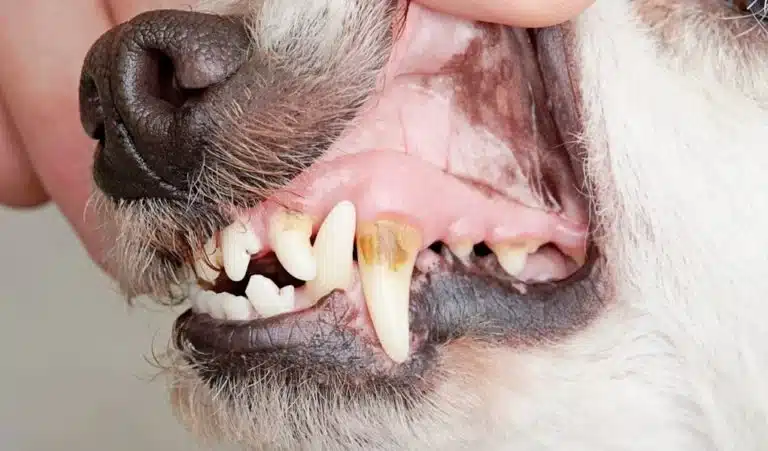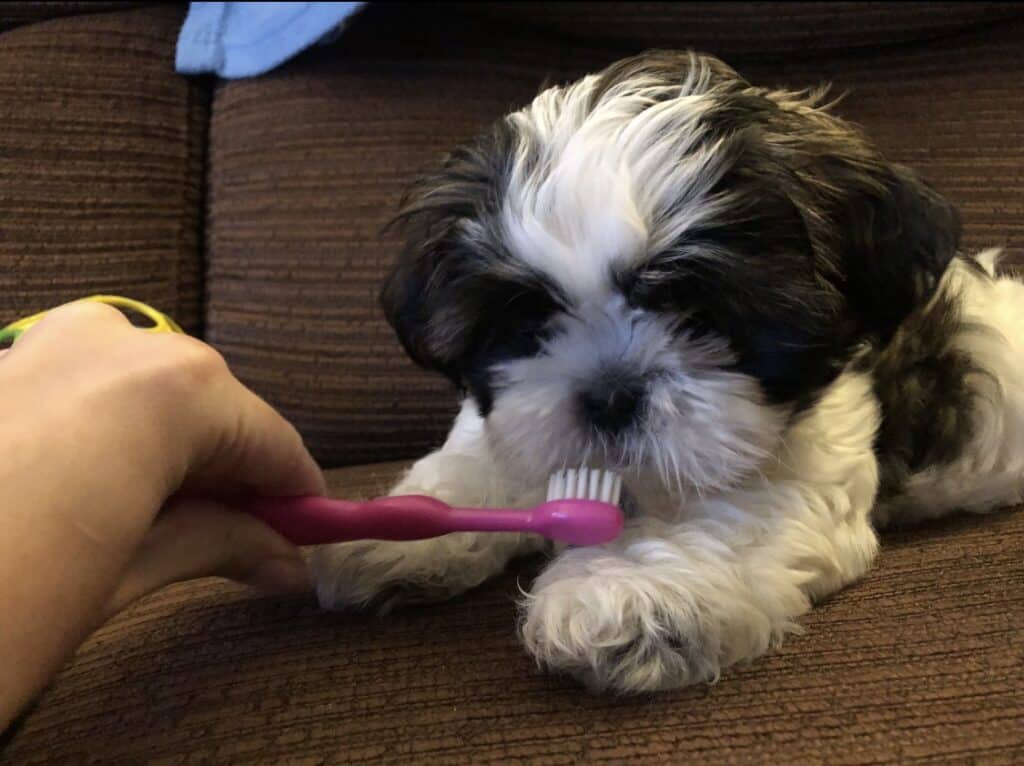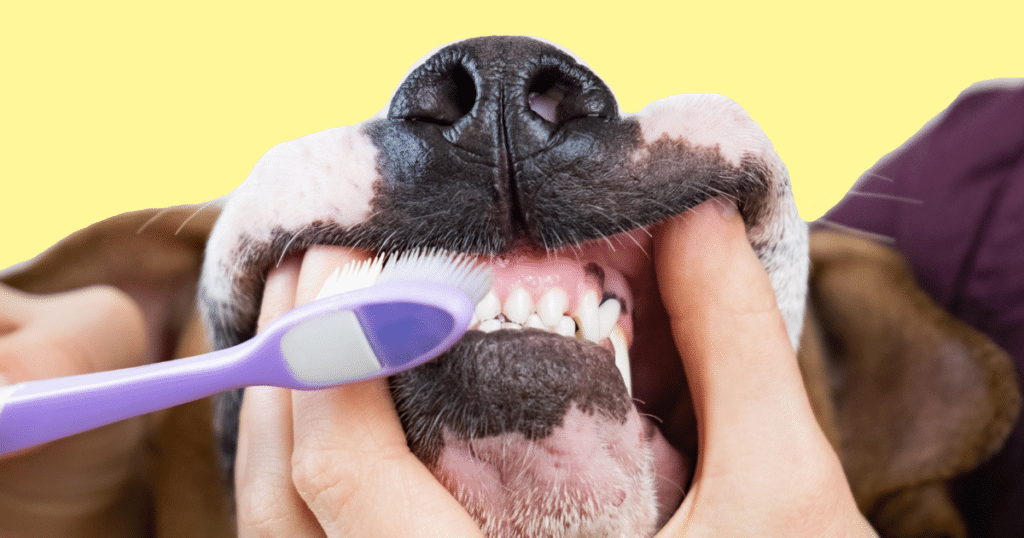Dental hygiene is very important not only to us but to our animals too. Did you know that 80-90 % of dogs over 3 years old suffer from dental disease? The best way is to prevent dental issues in the first place, so how can you get your dog used to having their teeth brushed?
Read more: How do I brush my dog’s teeth?What happens if I don’t brush my dog’s teeth?
Much like us, plaque buildup on the teeth turns into tartar. This can then irritate the gumline, leading to gingivitis (gum inflammation), the start of gum disease. Gum disease can be serious and doggy breath will be the least of their problems. Not only can it cause teeth to fall out, it can lead to serious bacterial infections of the organs, should this bacteria enter the bloodstream.

What happens if my dog already has bad breath?
Bad breath can be due to bad teeth, but it can also be down to other factors such as diet. Your vet should check your dog’s mouth when you take him in for his annual vaccinations, but if you have any concerns about your dog’s health, give your vet a call. If plaque has already built up on the teeth, the only way to help your dog is for them to have a dental under general anaesthetic.
How much do dental checkups cost?
Dentals can be surprisingly costly. Here’s why – your dog will need a general anaesthetic meaning they will have to be completely asleep and monitored during the procedure. Your pooch won’t sit in a dentist’s chair whilst the vet cleans his pearly whites, so this is the only option. The vet will use a special tool to remove the plaque and may need to take X-rays. If any teeth need to be extracted this will add to the cost and can easily amount to several hundred pounds. Whilst your dog is asleep, the vet can also check for missing teeth, broken or fractured teeth, loose teeth, overlapping or rotating teeth as well as any cysts or tumours.
Lots of pet insurance companies don’t cover dentistry so be sure to check with your provider beforehand. Lots of owners can be put off dental work due to this cost but most dogs are silent suffers and will continue to eat and act normally even if they are in pain.
What about having my dog’s teeth cleaned at the groomer?
Some groomers now offer non-sedation cleaning as an alternative to a dental at the vet’s, but it isn’t advisable. Your dog would be awake whilst this is done and scaling the teeth would be very painful if your dog has gingivitis. Also, only the visible plaque would be removed, not the tartar below the gumline which is the main source of gingivitis. Teeth need polishing after scaling as the scaling leaves grooves in the tooth. If this isn’t done, there is more surface area for tartar to adhere to making your dog’s teeth potentially worse in the long term. Scaling the teeth releases bacteria into the bloodstream and some patients require antibiotics after a dental to combat this, something only a vet can do.
Only a veterinary surgeon has the knowledge and ability to check your dog’s teeth. A groomer would have little training (if any) and would not be able to see if teeth needed extraction. Although they could remove the plaque, it doesn’t address further issues like gingivitis. A negative experience at the groomer having their teeth cleaned will make your dog associate anything to do with toothbrushing a negative experience making your daily toothbrushing much harder.
So how do I get my dog used to having their teeth brushed?
Ideally, this is something you do soon after you bring your dog home. Whilst puppies are usually easier to train, older dogs can be trained too. The first thing I did with Winnie was to get her used to having her face touched as she was quite shy around her mouth. I would touch her mouth and then give her a treat so she built up a positive association with hands being around her mouth. As Winnie is a short-faced breed, I found it difficult to lift her lip so I taught her the ‘chin’ command which is where she rests her chin in my hand. I repeated this over a few days touching her face, getting her to rest her chin and lifting her lip before introducing a toothbrush and toothpaste.
From this, you can build on it by letting your dog sniff the toothbrush and lick the toothpaste from it before gently starting to lift their lip and brush the teeth. Concentrate on the front part of the tooth and ensure you get the teeth right at the back too. It may take a while to get your dog used to it, but be patient and persevere.

Which toothpaste should I use?
There are lots of toothpastes on the market and it’s very important to use one specifically for dogs and not humans. This is because our toothpaste contains things in it that are designed to be spit out which a dog won’t do. Swallowing the toothpaste could make your dog unwell, so it’s best to use a doggy-specific one.
There are all different types on the market, but I recommend one that has an active ingredient which stays on the surface of the tooth keeping the active ingredients in contact with the teeth and gums. Logic and Virbac are both created to a veterinary standard and although are a bit more expensive, still cheaper than dental.
What toothbrush should I use?
There are a few different types of toothbrushes available and the type you go for will depend on your dog. Finger toothbrushes are popular and are nice and soft. There are double-headed ones like this that have two different sizes which are good for larger dogs. It is a bit trickier to find the right one for smaller dogs because they are so little, I found this one and this one is good for little dogs, but some people prefer to use a baby toothbrush.
Final thoughts
Dentals are best avoided where possible, not only due to the cost and risk of the anaesthetic especially on older dogs, but it is always better to prevent the disease from occurring in the first place. Brushing your dog’s teeth doesn’t have to be done daily, even every other day would be sufficient but if you get it into your routine, it will be easier to manage.

